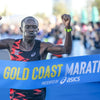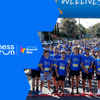How to Plan Your 2025 Race Calendar
1. Set Your Running Goals for 2025
Setting clear goals is the foundation of a successful race calendar. Before you start signing up for events, take some time to think about what you want to achieve in 2025. Establishing goals provides direction and keeps you motivated through the ups and downs of training. Here’s how to get started:
Define Your Objectives

Think about what excites you about running this year. Are you aiming to beat a personal record, test yourself with a new distance, or perhaps just immerse yourself in the social and community aspects of the running world? Everyone is different. Yours would be different to mine, and different to the person you're standing next to at the next start line.
Understanding your primary motivations will help guide your race choices. Here are a few common goals that might resonate with you:
-
Chasing a Personal Best (PB): If you’re aiming for a PB, your race calendar should include a few well-spaced key races that allow ample time for focused training and recovery. The fewer distractions from other events, the better your chances of reaching your peak.
-
Exploring New Distances: Perhaps this is the year to take on a marathon, an ultramarathon, or even tackle a 5K for the first time. Training for a new distance can be both exciting and challenging, so you’ll want to structure your calendar to allow for a gradual increase in training mileage.
-
Joining the Running Community: Running doesn’t always have to be about hitting a specific time. Some runners enjoy signing up for local events to connect with others, participate in charity runs, or simply enjoy the energy of race day. If this sounds like you, sprinkle community races throughout the year for a more relaxed and enjoyable approach.
Identify Key Focus Events

Once you’ve defined your objectives, select one or two “focus events” to centre your training around. These are the events where you’ll aim to perform at your best, so it’s crucial to give them the attention they deserve. Choosing these focus races early on can help shape the rest of your calendar, guiding your training cycles and allowing you to work towards a peak performance period.
Maybe for you it's big marathons like the Sydney or Melbourne Marathon, or perhaps it's epic trail marathons like Rollercoaster or Surf Coast Century.
-
Pick High-Impact Races: These might be well-known events you’ve always wanted to try, races with a challenging course, or ones that offer a special appeal, like a scenic route or a finisher’s medal you’re excited to earn.
-
Consider Timing and Location: When selecting your focus events, be mindful of the event dates and locations. If they require travel, consider the logistics and potential fatigue involved. Also, keep an eye on the climate and terrain to make sure it aligns with your goals and your training environment.
If you've been training in the Tassie winter, it might not make sense to be trying to get a PB at a North Queensland event in the peak of summer.
2. Balance Competitive and Community-Based Races

Mixing competitive and community-based races in your calendar adds variety, keeps your motivation high, and helps avoid burnout.
Competitive Races
Choose one or two competitive events where you aim to perform your best. These races should align with your goals, like achieving a personal best or smashing a new distance. Give yourself enough time to train and recover between these key events, they'll become your focus events.
- Training and Recovery: Plan training blocks leading up to competitive races, focusing on building both endurance and speed. This structured approach will help you reach peak performance on race day.
Community Events
Community races add a social element and are usually more relaxed. They’re a great way to stay connected to the running community without the pressure of a big performance.
There's nothing better than getting around your local event. There might only be 100 people, or there might be 2,000. Either way, being a part of your local community is important.
- Enjoyment and Motivation: These events are ideal for fun and offer a break from intense training. They’re also a budget-friendly way to keep your running calendar interesting and enjoyable.
Balancing both types of races will give you a fulfilling, varied race year that supports your goals and keeps you engaged with the running community.
3. Consider Race Frequency and Ideal Spacing

Finding the right balance in race frequency is key to staying injury-free and maintaining enthusiasm throughout the year.
Spacing Out Events
Allow enough time between races, especially for longer distances, to ensure proper recovery and avoid burnout. For instance, scheduling a marathon might require several weeks of recovery, while shorter races like a 5K may only need a few days.
This is purely a personal choice and depends on your goals. I meet people at events that will partake in a different race every two or three weeks for the whole year. They are there to be a part of a community, travel and keep fit.
Those looking to hit some PB's will likely be more selective of their events. Around 4-8 events for the year is a good number in my opinion, a mix of competitive, big and smaller community events.
- Recovery Time: Adjust spacing based on race distance and your personal recovery rate. Longer events generally need more time off to rebuild strength and stamina.
Avoiding Overload
While it’s tempting to sign up for every race that catches your eye, limiting your race frequency will help you stay focused and avoid fatigue. Aim for a maximum number of events that feel manageable and align with your experience level. It also gives you time to train for each specific event and adjust your program around it.
4. Budgeting: Race Entry Fees and Travel Costs

Planning a race calendar includes accounting for entry fees and any travel expenses. Setting a budget early will help you prioritise events that matter most. Race entries aren't free, so obviously consider that the more events you enter, the more it's going to cost over the year.
Race Entry Costs
Entry fees vary widely depending on the race size and location. Prioritise your key events and factor in registration costs, especially if you plan to travel for any major races.
- Plan for Early Registration: Many races offer early-bird discounts, so signing up in advance can save you money and secure your spot.
Travel Expenses
For races that require travel, consider transportation, accommodation, and food costs. Balancing local events with travel races can help you stick to your budget while still enjoying unique experiences.
Another hot tip is to incorporate a race with your holiday plans. Were you planning to head to Queensland next year? Great, then time it up with the Gold Coast Marathon. Heading to NT? Maybe the NT City2Surf is the one for you!
5. Include an Off-Season for Recovery and Strength Building

An off-season is crucial for sustained performance and long-term improvement. Many top athletes, including ultra-runner Sally McRae, emphasise that the off-season is the best time to build strength. During peak training, it’s challenging to develop strength while logging high mileage, so dedicating time to this during your off-season can pay off significantly.
Set a 6-12 Week 'Off-Season'
Plan a break of roughly 6-12 weeks at some point throughout the year. This off-season period allows for full recovery from prior events and a chance to build a strong foundation without the pressure of upcoming races.
It's definitely not about doing nothing, but it's about re-focusing your mind & body without the pressure or rigours of an upcoming event.
- Focus on Strength Training: Use this time to work on strength and mobility. Building a solid strength base can help prevent injuries and improve your endurance when race training ramps up again.
Recharge and Reset

Taking a mental and physical break from the demands of race training lets you reset and approach the next season with fresh energy and a stronger body.
By prioritising an off-season, you’ll enhance your race performance and longevity in the sport, ensuring each race season starts on a solid foundation.
Hopefully these tips give you a bit more clarity on how to choose your race events for 2025. Remember to prioritise your enjoyment of the sport first, then work backward.
Run well,
Robbie






You must have been reading my mind the other day at Frankston.
Just like this blog I’m aiming Two Bays to end my first running year. I’ll train towards a half marathon in May, Mornington, during my break Full Melbourne Marathon is the goal for 2025.
All events using Runly vests of course.